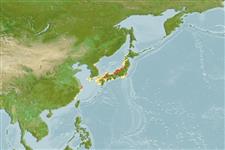Teleostei (teleosts) >
Syngnathiformes (Pipefishes and seahorses) >
Syngnathidae (Pipefishes and seahorses) > Syngnathinae
Etymology: Hippocampus: Greek, ippos = horse + Greek,kampe = curvature (Ref. 45335); haema: Name from Korean word Haema meaning ‘seahorse’, which connotes ‘representative’ and ‘common’; chosen to indicate that this seahorse is the one most commonly found in Korea.
Environment: milieu / climate zone / depth range / distribution range
Ecology
Marine; reef-associated; depth range 0 - 18 m (Ref. 117115). Temperate
Distribution
Countries | FAO areas | Ecosystems | Occurrences | Point map | Introductions | Faunafri
Northwestern Pacific: Korea and Japan.
Size / Weight / Age
Maturity: Lm ? range ? - ? cm
Max length : 11.4 cm SL male/unsexed; (Ref. 117115)
Short description
Identification keys | Morphology | Morphometrics
This species is distinguished by the following characters: bony body; double gill openings; R 10 + 35-38, mode 10 + 36 (holotype with 10 + 36); coronet is moderately high and turned back on top; CoT 4; CHGO 22.7-41.6 % HL; CHMC 34.1-54.9 % HL; a wing-tip spine (thick-recurved) on the dorsal fin base (Ref. 117115).
Lives in floating Sargassum and weeds on shallow soft bottom habitats (Ref. 117115).
Life cycle and mating behavior
Maturity | Reproduction | Spawning | Eggs | Fecundity | Larvae
Han, S.-Y., J.-K. Kim, Y. Kai and H. Senou, 2017. Seahorses of the Hippocampus coronatus complex: taxonomic revision, and description of Hippocampus haema, a new species from Korea and Japan (Teleostei, Syngnathidae). ZooKeys 712:113-139. (Ref. 117115)
IUCN Red List Status (Ref. 130435: Version 2024-1)
Threat to humans
Harmless
Human uses
Tools
Special reports
Download XML
Internet sources
